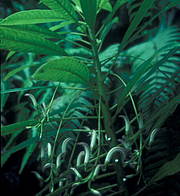This article was published in Scientific American’s former blog network and reflects the views of the author, not necessarily those of Scientific American
This week’s death of another northern white rhino—there are now just three in the world—presents the world with a rare and devastating opportunity: the chance to actually watch a species go extinct.
That doesn’t very often, because most extinctions happen far away from humans’ prying eyes. Populations decline, become scattered and flitter away. In most cases, no one is there to witness a species becoming a memory.
Scientists and conservationists don’t declare a species extinct all that often because, well, hope remains eternal. Even if they know that an existing population disappears, there’s always the possibility that the species itself still exists on the next hill over, or under a rock, or somewhere we have yet to search.
On supporting science journalism
If you're enjoying this article, consider supporting our award-winning journalism by subscribing. By purchasing a subscription you are helping to ensure the future of impactful stories about the discoveries and ideas shaping our world today.
Sometimes, however, hope is hard to hang on to. That’s why 25 species have just been identified as “critically endangered, possibly extinct” in the latest update to the IUCN Red List of Threatened Species.
The list of possibly extinct species includes a frog, numerous orchids, several Hawaiian plants and a lost legume—all of which have not been seen for many years, but none of which conservationists have completely given up hope about.
Let’s take a look at these potentially lost species:
Rhynchosia ledermannii — Last seen in 1908, this Cameroonian legume came from just a since site smaller than 4 square kilometers. The only known specimen has since been lost, as has the original habitat.
Stereospermum zenkeri — Also from Cameroon, this tree grew in within an 8 square kilometer region that has now become urbanized. It was last seen in 1950.

Cyanea kolekoleensis — When this Hawaiian plant was discovered in 1987 the entire species consisted of just 15 mature individuals. Pigs, invasive plants and 1992’s Hurricane Iniki whittled that number down pretty quickly. The last individual plant was seen in 1998. Attempts to propagate this species in a greenhouse failed and that habitat where it could grow in the wild, if it still exists, continues to degrade.
Delissea rhytidosperma and D. takeuchii — These two flowering plant species were last seen on the Hawaiian islands of Kaua’i and O’ahu in 2002 and 1987. Competition from non-native plants and predation by invasive pigs did them both in. D. rhytidosperma still exists in the National Tropical Botanical Garden, but the chances of it returning to the wild seem slim.
Kadua haupuensis — Another Hawaiian plant, this time from Kaua’i. Only seven plants were ever known in the wild—all of which were wiped out in a landslide in 1998. This is another plant with a sliver of hope. According to the IUCN, “nine accessions grown from seed from the original plants in the wild are in living collections at the National Tropical Botanical Garden on Kaua’i, and there are 69,300 seeds in storage.”
Phyllostegia kahiliensis and P. knudsenii — More Hawaiian plants with the same threats posed by invasive species. These were last seen in 1987 and 2001.
Silene perlmanii — Yup, another Hawaiian plant. Yup, the same threats. Last seen on O’ahu in 1997. Seeds exist, but we’ve never gotten them to grow enough to reproduce on their own.
Stenogyne bifida and S. kanehoana — Two of the most recent probably disappearances on this list, these plants were last seen on Moloka'I and O’ahu in 2014 and 2013, respectively. Seeds exist, and cultivation is ongoing for the latter species.
Bulbophyllum erythroglossum, B. hirsutiusculum, B. minax, B. sanguineum and B. tampoketsense — These orchids, all native to Madagascar, each had incredibly small known habitats which have now been degraded by wood harvesting and subsistence agriculture. Illegal orchid collectors also took their toll. They were last seen in 1964, 1928, 1919, 1925 and 1923, respectively.
Cynorkis bimaculata, C. catatii, C. rolfei and C. sylvatica — More missing Madagascar orchids. Last seen in 1961, 1889, 1903 and 1951.
Disperis bosseri, Eulophia grandidieri and Hymenodictyon seyrigii — More orchids. Last seen in 1957, 1901 and 1942.
Lepidoblepharis miyatai — This tiny gecko once lived alongside several other lizard species on a beach on the Caribbean coast of Colombia that is popular with herpetological collectors. It was only seen once—a single day in August 1964. It hasn’t been observed since.
The Arico water frog (Telmatobius pefauri) — The only species on this list with a popular name, this frog from a mountain in northern Chile hasn’t been seen since 1976, the only time it was ever observed. The streams the frogs once swam in have since been drained to provide water for human use and cattle ranching. It’s hard to be a water frog if there’s no water left in which to swim.
Of course, there’s always hope that any of these species could turn up again. It happens all the time. Case in point, the Mahé boulder cricket (Phalangacris alluaudi), which the IUCN Red List previously listed as possibly extinct. It was rediscovered last year and it is now listed as critically endangered. That may not be great news, but it’s a rare win in the fight against extinction.
Photos courtesy of IUCN